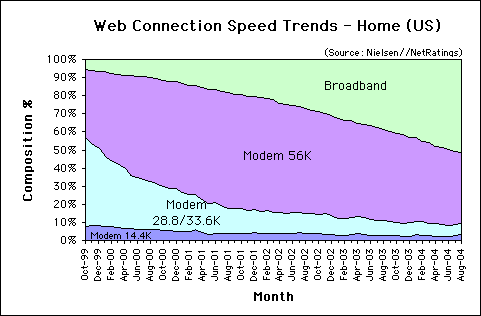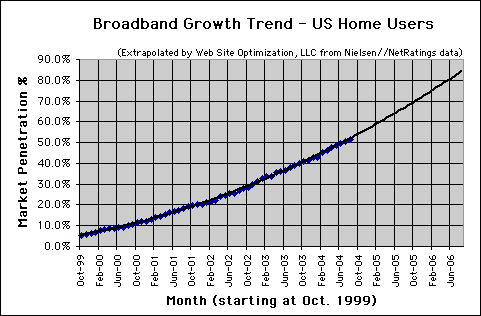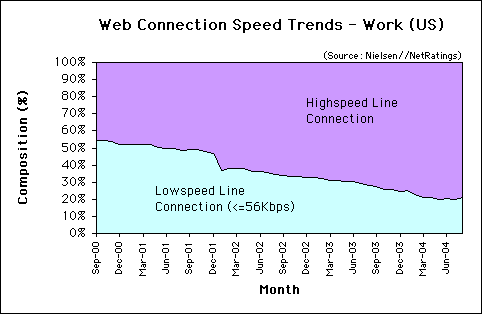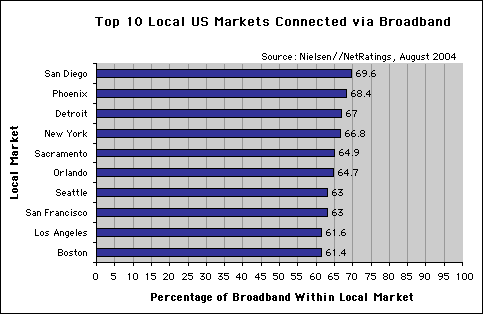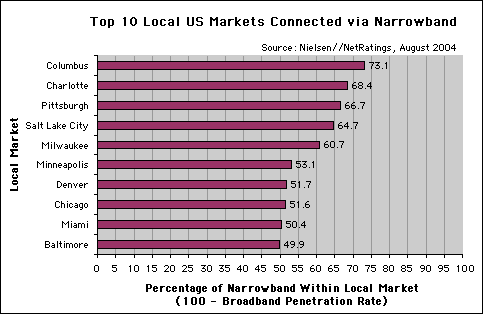U.S. broadband penetration continued its steady growth past 50% among active Internet users in August. US broadband penetration grew by 0.73 percentage points in August, with 51.42% of active Internet users on high-speed connections at home. 48.58% of US home users dial into the Internet with “narrowband” connections of 56Kbps or less. Meanwhile, out on the beach, broadband penetration tends to be higher in affluent coastal cities, according to a recent survey of local markets by Nielsen//NetRatings.
The charts below, derived from Nielsen//NetRatings data, show trends in connection speeds to the Internet for United States users.*
Home Connectivity in the US
In August 2004, most active Internet users connect from home with broadband connections. Among narrowband users, 38.90% use 56Kbps modems, 6.07% use 28/33.3Kbps, and 3.61% use 14.4Kbps modems. In total, 48.58% of home users in the US connect to the Internet at 56Kbps or less (see Figure 1).
Web Connection Speed Trends – Home Users (US)
Figure 1: Web Connection Speed Trends – Home Users (US)
Source: Nielsen//NetRatings
Broadband Growth in the US
Broadband penetration in the US increased by 0.73 points to 51.42% in August, up from 50.69% in July. This jump of 0.73 points is well below the average increase in broadband of 1.04 points per month in the past year (and the past 6 months). Extrapolating the data provided by Nielsen//NetRatings, broadband share in the US should exceed 70% by November of 2005 (see Figure 2).
Broadband Connection Speed Trend – Home Users (US)
Figure 2: Broadband Connection Speed Trend – Home Users (US)
Extrapolated from Nielsen//NetRatings data
Work Connectivity
Most workers in the US enjoy high-speed connections to the Internet. Most use a high-speed line such as a T1 connection, and share bandwidth between computers connected to an Ethernet network. The speed of each connection decreases as more employees hook up to the LAN. As of August of 2004, of those connected to the Internet, 79.06% of US users at work enjoy a high-speed connection, down 1.15 percentage points from 80.21% in July. 20.94% connect from work at 56Kbps or less (see Figure 3).
Web Connection Speed Trends – Work Users (US)
Figure 3: Web Connection Speed Trends – Work Users (US)
Source: Nielsen//NetRatings
Broadband Penetration Higher in U.S. Coastal Cities
In a survey of the top local markets, Nielsen//NetRatings found that coastal cities, which tend to have more affluent communities and large professional workforces, tend to have higher broadband penetration than more inland communities (see Figure 4). San Diego, Phoenix, Detroit, New York, and Sacramento led the nation in broadband penetration while Columbus, Charlotte, Pittsburgh, Salt Lake City, and Milwaukee led the nation in “narrowband” connectivity (see Figure 5).
Further Reading
- “Bandwidth Constraints to Using Video and Other Rich Media in Behavior Change Websites” (2005)
- This issue of the Bandwidth Report was cited in this paper on rich media by Brian G Danaher, PhD, Stephen A Jazdzewski, H Garth McKay, PhD & Clinton R Hudson Journal of Medical Internet Research, vol. 7 no. 4.
- Nielsen//NetRatings
- Provides the US broadband data (percentage of active Internet users) for the Bandwidth Report.
- San Diego, Phoenix and Detroit Lead Broadband Wired Cities (PDF)
- Coastal communities in the U.S., which tend to be more affluent with large professional workforces, have higher broadband penetration than inland communities that tend to have more narrowband connections. Nielsen//NetRatings, September 15, 2004.
*Note that Nielsen//NetRatings reports the percentage of active Internet users that use broadband from home, not broadband households. NetRatings uses a panel of 40,000 to 50,000 people with software meters installed on their computers. These meters detect connection speeds. Each month they do an enumeration study to call a number of people to calibrate the panel by adjusting weightings to match the population at large.
The Bandwidth Report is featured monthly on URLwire – news of useful and unique web content since 1994.

